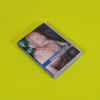A portrait of an unnamed city in Italy. Sidestepping the tourist attractions that make the city famous, the film/video posits an almost-imaginary place that draws closer to the reality of its inhabitants. Using a voiceover narration that collages direct observation, literary texts, historical fact, local folklore, and a bit of sheer fabrication, the film/video melds documentary and narrative, past and present.
- Home
- Home DVD
An experimental documentary about the street drag racing scene on Chicago’s near West Side. This is a rambling textured film about obsession. It is about the mythos of speed for its own sake, but it’s also about waiting, and it is through waiting that The BLVD exposes community, inner-city landscapes and nomadic experiences of place. The film treats storytelling as a living medium for determining history. And it commands respect, for those who transform cars, or anything else, through passion.

Kevin Jerome Everson’s prolific body of work is grounded in formalism and combines scripted and documentary elements. The subject matter is the gestures or tasks caused by certain conditions in the lives of African-Americans and people of African descent, often working class. The conditions are usually physical, social and economic circumstances, or weather. His films suggest the relentlessness of everyday life — along with its beauty — and present oblique metaphors for art making.

"A meditation on history, memory, and change in Central and Eastern Europe, Buried in Light is a non-narrative journey, a cinematic collage. Cohen’s “search for images” began at a time of extraordinary flux, as the Berlin Wall was dismantled—opening borders yet ushering in a nascent wave of consumer capitalism. What he saw struck him as a profound paradox: the moment Eastern Europe was revealed was simultaneously the moment it was hidden by the blinding light of commercialism.

Executive produced by Sara Diamond at the Banff Art Centre, co-produced by Michelle Baughn and Suzanne Lacy, directed by Tom Weinberg and Dick Carter, and edited by Holen Kahn.

In the spring of 1988, video-maker/activist Gregg Bordowitz tested HIV-antibody positive. He then quit drinking and taking drugs and came out to his parents as a gay man. This imaginative autobiographical documentary began as an inquiry into these events and the cultural climate surrounding them. While writing the film, a close friend was diagnosed with breast cancer and his grandparents were killed in a car accident. The cumulative impact of these events challenged his sense of identity, the way he understood his own diagnosis, and the relationships between Illness and history.

An experimental documentary comprised of regional vignettes about faith, force, technology and exodus. Eleven parables relay histories of settlement, removal, technological breakthrough, violence, messianism and resistance, all occurring somewhere in the state of Illinois. The state is a convenient structural ruse, allowing its histories to become allegories that explore how we’re shaped by conviction and ideology.

Four short videos by artist Miranda July, covering the period 1996 to 2001.

Cohen shot Little Flags in black and white on the streets of lower Manhattan during an early 90s military ticker-tape parade and edited the footage years later. The crowd noises fade and Cohen shows the litter flooding the streets as the urban location looks progressively more ghostly and distant from the present. Everyone loves a parade — except for the dead.

An independent film portrait of singer/songwriter Elliott Smith in Portland, Oregon in 1996, wherein he plays three songs. The songs were done live acoustic--in his old studio, a living room, and a bathroom (it was quiet in there). It's also a small portrait of Portland, Oregon.
The songs are "Between the Bars", "Angeles", and a cover of "Thirteen" by Big Star.
This is Elliott as I remember him, at his simple finest as musician.

Inventing freedom as they roam, videomaker Ellen Spiro and her dog Sam go west in a vintage Airstream trailer in search of elderly dropouts and their dogs who have pulled out of society and into by-the-side-of-the-road trailer communities. Our mutt narrator tells his tale, sharing his thoughts on America’s smells, the foibles of humans, and his view of aging as another journey. In unplanned meetings with gray nomads, psychic misfits, and free spirits, Roam Sweet Home takes the myths of growing older and turns them on their head.

Until his untimely death from AIDS in 1992, Tom Rubnitz produced short, humourous videotapes featuring some of New York’s most outrageously talented musicians, artists and drag queens. Influenced by mass media entertainment, Rubnitz crafted hilarious videos which simultaneously celebrated and parodied pop culture’s bountiful energy and inventiveness. As Tom said, “I wanted to make things beautiful, funny and positive—escapes that you could just get into and laugh through. That was really important to me.

Beloved by filmmakers such as John Waters and Todd Solondz, George Kuchar worked with the moving image for over half a century. In the 1950s, Kuchar and his twin brother Mike began producing ultra-low-budget underground versions of Hollywood genre films, with names like I Was a Teenage Rumpot and The Devil’s Cleavage.





